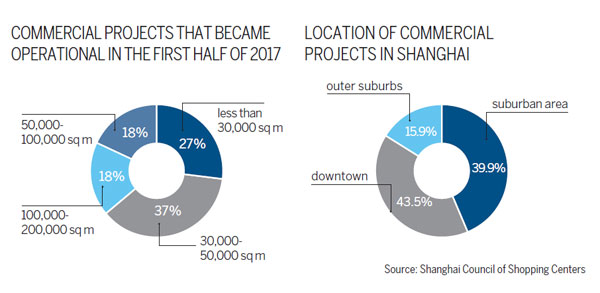The evolution of shopping
|
 |
Staying ahead of the curve
But shopping malls, just like any other retail mode, are subjected to a cycle of growth and decline. Shopping centers in Shanghai's downtown Huangpu district have experienced a 4 percent revenue decline over the past six years, according to the Shanghai Council of Shopping Centers.
"Shopping centers need to consistently innovate in line with its brand, function, position, target customers, and offer more value-added services to customers to improve their shopping experience," said Chen Tiedong, director of Colliers' East China research division.
Over the past few years, many malls have reinvented themselves to become more than just a retail space, introducing elements such as dining, entertainment, education and arts to their premises. Presently, 300,000 sq m of prime retail space in Shanghai - 12 percent of the city's total prime stock - are undergoing refurbishment in order to better attract consumers.
"The scale of refurbishment being done to malls in 2017 has never been seen before in Shanghai's retail market," said James Macdonald, head of Savills China research.
"The new life being breathed into these older developments has the chance to stimulate leasing demand in prime areas in 2018."
Fan Hongjuan, head of CBRE Eastern China advisory and transaction retail, said that society has now entered a post shopping mall era that has compelled new market players to devise innovative market strategies to attract Chinese customers.
One of these methods is to introduce a theme to the mall in order to draw customers beyond its target areas.
"Usually, consumers of a shopping mall are those who live within 3 kilometers, but the introduction of a popular theme could attract people across the city, which is a rather effective boost for business," added Chu.
Located along Huaihai Road, Central Plaza plans to introduce new flagship stores and restaurant brands to attract young and stylish customers. Meanwhile, Sun Hung Kai Properties' IFC mall, a high-end luxury shopping complex, has leveraged Virtual Reality technology to create a more interactive and entertaining mall experience for customers.
"As a matter of fact, we have already seen some eye-opening examples in other countries, such as the Dubai Mall where people can experience the exhilaration of flying the Emirates A380 plane using a cutting-edge flight simulator," said Chen.
Integrated shopping
Looking ahead, Chu suggested that traditional retailers place more emphasis on segmented marketing while expanding their multi-channel offerings.
He added that there are certain retail segments that cannot be effectively replaced by e-commerce because the latter is unable to replicate the actual shopping experience, and that the boundary between online and offline is becoming blurred as the majority of brands offer services in both forms.
"We can hardly draw a clear line between offline and online now, and that is future of all retailers," said Chu.
Fan echoed this sentiment, saying: "I've always thought that online and offline shopping can complement instead of being in conflict with one another. The changing nature of the market requires all retailers to catch up with the trends no matter if it is online or offline."
Lu Haidong from SML Centers pointed out that despite the convenience, lower prices and the wide selection of products provided by e-commerce sites, online retail ultimately lacks the human element which makes shopping fun for certain customers.
He noted that some people looking to buy luxury items would rather shop in a physical store to minimize the risk of getting a counterfeit product. Getting refunds or exchanging a purchase is also easier in a physical store.
"E-commerce helps people to buy things without stepping out of their homes. But humans are social creatures after all, and a visit to physical stores can make up for the absence of social elements," said Lu, noting that unlike Chinese shoppers, Japanese prefer physical stores over e-commerce because they enjoy the high quality of service rendered.
"In addition, shopping is not purely about buying necessities, but sometimes an activity for psychological needs."
The need to be in tune with current trends is also part of human nature. Lu said this is why shopping malls are increasingly featuring brands that are popular among young consumers.
Retail consumption in China reached 17.24 trillion yuan, up 10.4 percent year-on-year, from January to June this year, according to the National Bureau of Statistics. Data by local statistics bureaus revealed that Shanghai had during the same period overtaken Beijing for the first time to become the top city in China in terms of consumption, with retail revenue amounting to 567 billion yuan.
















